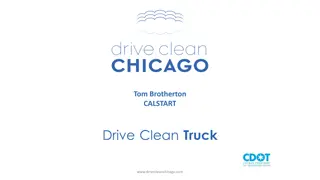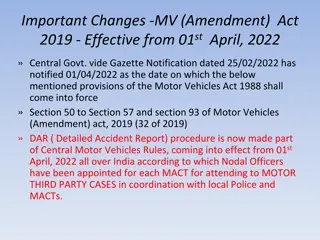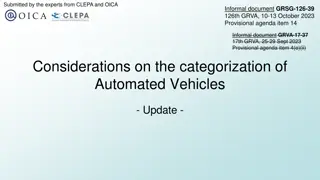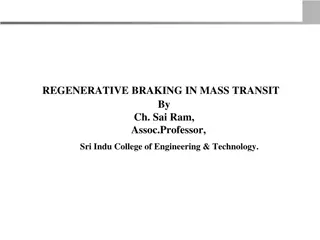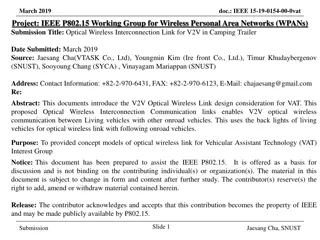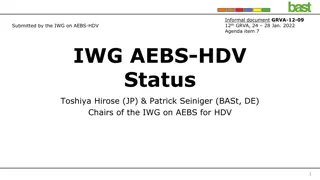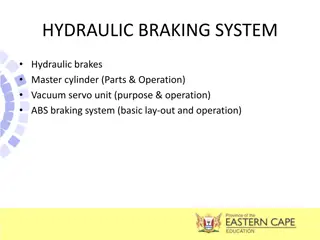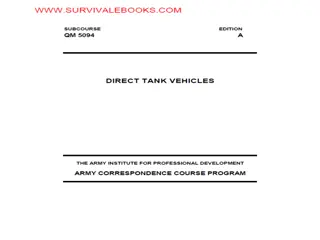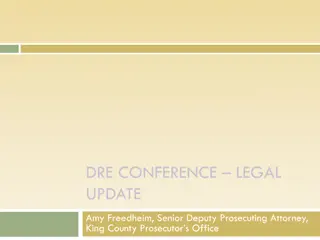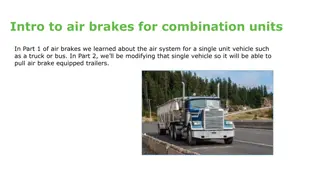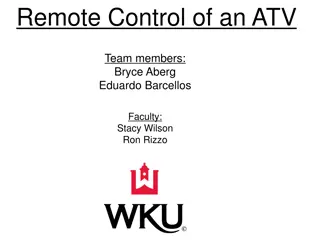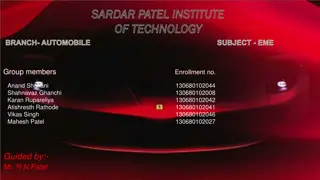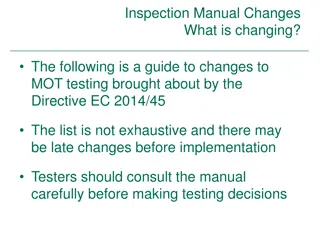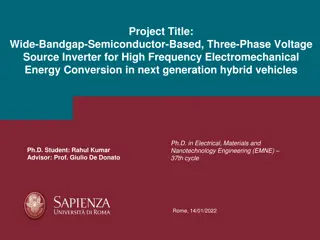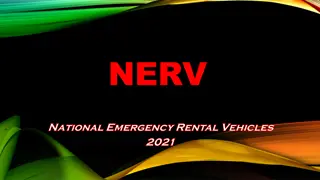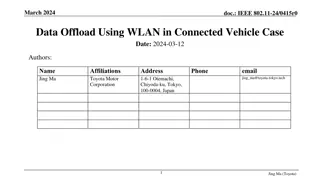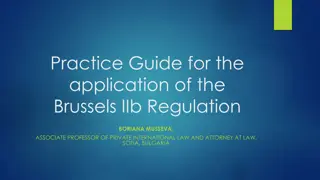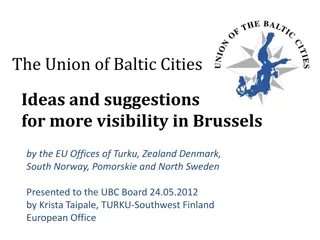Advancements in Electromechanical Brakes for Vehicles Presented at Workshop in Brussels
Overview of new technical concepts and the scope of Electro-Mechanical Brakes (EMB) amendment, focusing on electric transmission and energy efficiency improvements. The presentation covers the motivation, advantages, and principles of EMB, emphasizing the elimination of noise emissions, improved braking control, and energy transmission efficiency over pneumatic systems. The discussion also includes details on received energy types for different powertrains and the comparison between Pneumatic and Electric Energy Transmission in the context of EBS and E-APU systems.
Download Presentation

Please find below an Image/Link to download the presentation.
The content on the website is provided AS IS for your information and personal use only. It may not be sold, licensed, or shared on other websites without obtaining consent from the author. Download presentation by click this link. If you encounter any issues during the download, it is possible that the publisher has removed the file from their server.
E N D
Presentation Transcript
Presentation GRVA-EMB-02/Rev.1 Electromechanical Brakes and UNECE R13/R13 Electromechanical Brakes and UNECE R13/R13- -H H March 29th th/30 /30th th Workshop in Brussels Workshop in Brussels March 29 1
Day 1, 10:00 Day 1, 10:00 12:00 12:00 1. Overview of new technical concepts for 1. Overview of new technical concepts for Electro Electro- -Mechanical Brakes Mechanical Brakes 2
Electro Electro- -Mechanical Brakes (EMB) Mechanical Brakes (EMB) Purpose and Scope Purpose and Scope Electric transmission: o Current regulation for the service braking only addresses electric control transmission o The purpose of the EMB amendment is to address also electric energy transmission in the regulation In a first step for UNECE-R13, the scope is limited to EMB on the motor vehicle; the trailer remains as today 3
Agenda item 1.(a) UN R13 and Electro UN R13 and Electro- -Mechanical Brakes (EMB) Mechanical Brakes (EMB) Amendment scope and motivation Amendment scope and motivation Motor vehicle with EMB brakes on all axles (not mixed with Pneumatic Or Hydraulic systems) Motor vehicle with EMB brakes with conventional trailer interface according to current UN R13 Trailers with EMB excluded from scope UN R13-H not included but considered, in particular when creating new definitions Advantages and possibilities by amending Electric Energy Transmission to UN R13 Improved energy efficiency in EV s (vs. air compressor) Improved braking control 4 Elimination of noise emissions from pneumatics
Received Energy Type of powertrain 1.(a) Supply Supplied energy Conditioning source + Governor valve + Air dryer compressed air pressurized fluid vacuum low voltage power COMPRESSOR MECHANICAL ICE Energy supply 24V ALTERNATOR PUMP BEV No source low voltage power Energy supply HIGH VOLTAGE POWER DC/DC ICE Generator TB Hybrid
1.(a) UN R13 and Electro UN R13 and Electro- -Mechanical Brakes (EMB) Mechanical Brakes (EMB) Energy Transmission principles (Pneumatic vs. Electric) EBS Pneumatic energy storage EBS Modulator Caliper Actuator E-APU Pneumatic Energy Annex 7 part A 5.2.1.27 Energy supply Actuation Energy reserve EMB New 5.2.1.35. Annex 7 new part D Electric Energy Electric energy storage DC/DC Caliper Gears Drive and Motor 6
1.(b) Motivation amending UN R13 Motivation amending UN R13- -H on Full Power Braking Systems Braking Systems H on Full Power Full Power Braking Systems are under development as an alternative to conventional hydraulic braking systems. Currently potential approvals to UN-R 13H/01 Suppl.4 for such Full Power Braking Systems are unclear due to missing defnitions and requirments. 7 GRVA Workshop EMB (29th - 30th of March 2023,Brussels) I Input Passenger Cars
Classification Classification Brake by Wire (BBW) versus Electro Mechanical Brake (EMB) Agenda item 1.(b) Control and Energy Transmission Brake By Wire (BBW) Energy Transmission EMB a mix of energy electrical power only is converted to actuating forces by purely mechanical means is converted to actuating forces by purely mechanical means electro-hydraulic braking system electric-mechanic braking system (EHB) (EMB) electric-mechanic/ electro-hydraulic braking system (EMB-EHB) 8 GRVA Workshop EMB (29th - 30th of March 2023,Brussels) I Input Passenger Cars
Day 1, 13:00 Day 1, 13:00 18:00 18:00 2. Traditional brakes and new concepts 2. Traditional brakes and new concepts 9
Main challenges Main challenges Keep same safety level as with current technologies Account for new technology, while avoiding design restrictions Keep the requirements performance-/function oriented Avoid unwanted side-effects on existing regulation Keep R13 and R13-H definitions and principles aligned Example technical challenge: Effect of ageing and temperature on the performance of energy storage devices Example regulatory challenge: Ensure energy warnings are displayed to the driver acc. to performance level 10
Day 1, 13:00 Day 1, 13:00 16:00 16:00 Traditional brakes and new concepts Traditional brakes and new concepts (2a) Full EMB for Heavy Duty Motor Vehicles 11
I. II. Energy Source, Supply ,Storage and friction brake actuation System Board-net (Energy and Control transmissions) - - - Existing typical layout (EBS) Intermediate layout between EBS and EMB Targeted EMB principal layouts
Energy transmission = pneumatic Control transmission = electric + pneumatic (backup) Agenda item 2.(a) R13 - Existing typical layout - EBS Mechanical drive Energy Reserve 1 Compressor Circuit 1 Brake Valve 2 ICE Brake Valve 1 Supply Tank Energy Reserve 2 Circuit 2 Alternator Brake Controller energy source of the electric control transmission (5.2.1.27.5) 3 1 2 Energy Supply * (including energy source, if any) Energy Reserve Transmission KL 30.1 Battery 24V Control Transmission I I Pneumatic Electric Energy Transmission IElectric I Pneumatic Control 2.5.1. "Control transmission" means the combination of the components of the transmission which control the operation of the brakes, including the control function and the necessary reserve(s) of energy. to be defined
Energy transmission = pneumatic Control transmission = electric + pneumatic (backup) 2.(a) R13 - Existing typical layout - EBS Energy Reserve 1 Electric Compressor Circuit 1 Traction Battery (HV) Brake Valve 2 Brake Valve 1 Supply Tank Energy Reserve 2 Circuit 2 DC/DC Brake Controller 3 1 2 Energy Supply * (including energy source, if any) Energy Reserve Transmission KL 30.1 Battery 24V Control Transmission I I Pneumatic Electric Energy Transmission IElectric I Pneumatic Control 2.5.1. "Control transmission" means the combination of the components of the transmission which control the operation of the brakes, including the control function and the necessary reserve(s) of energy. to be defined
Energy transmission = pneumatic Control transmission = electric 2.(a) R13 - Intermediate step between EBS and EMB Energy Reserve 1 Electric Compressor Circuit 1 Traction Battery (HV) Brake Valve 2 Brake Valve 1 Supply Tank Energy Reserve 2 Circuit 2 DC/DC Brake Brake Controller 2 Controller 1 1 2 Energy Supply * (including energy source, if any) Energy Reserve Transmission Control Transmission I I Pneumatic Electric Battery 1 Energy Transmission IElectric I Pneumatic Control to be defined Battery 2
Energy transmission = electric Control transmission = electric 2.(a) R13 EMB Targeted layouts layout 1a (Electro-Mechanical-Brake) Energy Reserve 1 Specific battery to braking KL 30.1 DC /DC Circuit 1 Traction Battery (HV) Brake Controller 2 Brake Controller 1 Battery 24 V Energy Reserve 2 Circuit 2 1 2 Energy Supply * (including energy source, if any) Energy Reserve Transmission Control Transmission Energy Transmission IElectric I Hydraulic Control to be defined
Energy transmission = electric Control transmission = electric 2.(a) Energy Reserve 1 R13 EMB Targeted layouts layout 1b (Electro-Mechanical-Brake) Battery 24V battery for braking And other consumers KL 30.1 DC /DC Circuit 1 Traction Battery (HV) Brake Controller 2 Brake Controller 1 Battery 24V Circuit 2 1 2 Energy Reserve 2 Energy Supply * (including energy source, if any) Energy Reserve Transmission Control Transmission Energy Transmission IElectric I Hydraulic Control to be defined
Agenda item 2.(a) UN R13 Today 5.2.1.2.7.2. If the service braking force and transmission depend exclusively on the use, controlled by the driver, of an energy reserve, there shall be at least two completely independent energy reserves, each provided with its own transmission likewise independent; each of them may act on the brakes of only two or more wheels so selected as to be capable of ensuring by themselves the prescribed degree of secondary braking without endangering the stability of the vehicle during braking; in addition, each of the aforesaid energy reserves shall be equipped with a warning device as defined in paragraph 5.2.1.13. below. In each service braking circuit in at least one of the air reservoirs a device for draining and exhausting is required in an adequate and easily accessible position;
Energy transmission = pneumatic Control transmission = electric + pneumatic (backup) 2.(a) R13 - Existing typical layout - EBS Energy Reserve 1 Electric Compressor Circuit 1 Traction Battery (HV) Brake Valve 2 Brake Valve 1 Supply Tank Energy Reserve 2 Circuit 2 DC/DC Brake Controller 3 1 2 Energy Supply * (including energy source, if any) Energy Reserve Transmission KL 30.1 Secondary performance Battery 24V Control Transmission I I Pneumatic Electric Energy Transmission IElectric I Pneumatic Control 2.5.1. "Control transmission" means the combination of the components of the transmission which control the operation of the brakes, including the control function and the necessary reserve(s) of energy. to be defined
Energy transmission = electric Control transmission = electric 2.(a) R13 EMB Targeted layouts layout 1a (Electro-Mechanical-Brake) Energy Reserve 1 Specific battery to braking KL 30.1 DC /DC Circuit 1 Traction Battery (HV) Brake Controller 2 Brake Controller 1 Battery 24 V Energy Reserve 2 Circuit 2 1 2 Energy Supply * (including energy source, if any) Energy Reserve Transmission Secondary performance Control Transmission Energy Transmission IElectric I Hydraulic Control to be defined
2.(a) UN R13 Today 5.2.1.5. Where use is made of energy other than the muscular energy of the driver, there need not be more than one source of such energy (hydraulic pump, air compressor, etc.), but the means by which the device constituting that source is driven shall be as safe as practicable.
Energy transmission = pneumatic Control transmission = electric + pneumatic (backup) 2.(a) R13 - Existing typical layout - EBS Energy Reserve 1 Electric Compressor Circuit 1 Traction Battery (HV) Brake Valve 2 Brake Valve 1 Supply Tank Energy Reserve 2 Circuit 2 DC/DC Brake Controller 3 1 2 Energy Supply * (including energy source, if any) Energy Reserve At least 8 applications before Secondary performance Transmission KL 30.1 Battery 24V Control Transmission I I Pneumatic Electric Energy Transmission IElectric I Pneumatic Control 2.5.1. "Control transmission" means the combination of the components of the transmission which control the operation of the brakes, including the control function and the necessary reserve(s) of energy. to be defined
Energy transmission = electric Control transmission = electric 2.(a) R13 EMB Targeted layouts layout 1a (Electro-Mechanical-Brake) Energy Reserve 1 Specific battery to braking KL 30.1 DC /DC Circuit 1 Traction Battery (HV) Brake Controller 2 Brake Controller 1 Battery 24 V Energy Reserve 2 Circuit 2 1 2 Energy Supply * (including energy source, if any) Energy Reserve At least 8 applications before Secondary performance Transmission Control Transmission Energy Transmission IElectric I Hydraulic Control to be defined
2.(a) Proposed definitions Proposed definitions e.g. compressor, pump, alternator But not the traction battery nor a DC/DC converter "Energy source" means a device which receives energy and converts it into the required form (i.e. medium). An energy storage device is not considered as a source. Energy supply means all parts, including an energy source, if any, that are necessary to supply energy for the operation of the braking system. The supplied energy can be used to be stored in the energy storage devices and/or can be used directly to feed the control transmission and/or the energy transmission. e.g. DC/DC converter Energy reserve means the stored energy needed for the operation of the braking system.
Day 1, 16:30 Day 1, 16:30 18:00 18:00 Traditional brakes and new concepts Traditional brakes and new concepts (b) Provistion of Energy for braking systems on passenger cars (ICE and BEV) (c) Hybrid brake system on passenger cars (e.g. hydraulic front-, electro mechanic rear axle) Passenger Car layouts - - - electro-mechanical-brake electro-hydraulic-brake electro-mechanical-brake / electro-hydraulic-brake 26
Agenda item 2(b) R13H todays layout Full Power Braking Systems with mechanical fallback UN R13-H, para. 5.2.2.9. LV Battery KL 30 DC/DC Brake Control Unit Traction Battery (HV) hydraulic hydraulic Circuit 1 Circuit 2 hydraulic hydraulic with mechanical fall back Other consumers Steering System Energy Supply (including energy source, if any) Energy Reserve Transmission Control Transmission Energy Transmission IElectric I Hydraulic Control Not exclusively used by braking system, but total vehicle functions, e.g. Steering GRVA Workshop EMB (29th - 30th of March 2023,Brussels) I Input Passenger Cars 27
2(b) R13H Targeted layouts layout 1a # (electro-mechanical-brake) LV-Battery KL 30.1 DC /DC Circuit 1 Traction Battery (HV) Brake Controller 2 Brake Controller 1 KL 30.2 Circuit 2 DC/DC 1 2 Energy Supply (including energy source, if any) KL 30.1 = (+) circuit1 KL 30.2 = (+) circuit2 There can be [n] circuits(*) Steering System Other consumers Energy Reserve Transmission Control Transmission Energy Transmission IElectric I Hydraulic (*) 5.2.8. The action of the service braking system shall be distributed between the wheels of one and the same axle symmetrically in relation to Control Not exclusively used by braking system, but total vehicle functions, e.g. Steering the longitudinal median plane of the vehicle. GRVA Workshop EMB (29th - 30th of March 2023,Brussels) I Input Passenger Cars 28
2(b) R13H Targeted layouts layout 2a # (electro-hydraulic-brake) LV-Battery KL 30.1 DC /DC hydraulic Traction Battery (HV) Brake Brake Controller1 hydraulic Controller 2 hydraulic Modulator 2 Modulator 1 hydraulic KL 30.2 DC /DC 1 2 Energy Supply (including energy source, if any) KL 30.1 = (+) circuit1 KL 30.2 = (+) circuit2 There can be [n] circuits(*) Other consumers Steering System Energy Reserve Transmission Control Transmission Energy Transmission IElectric I Hydraulic (*) 5.2.8. The action of the service braking system shall be distributed between the wheels of one and the same axle symmetrically in relation to the longitudinal median plane of the vehicle. Control Not exclusively used by braking system, but total vehicle functions, e.g. Steering GRVA Workshop EMB (29th - 30th of March 2023,Brussels) I Input Passenger Cars 29
2(c) R13H Targeted layouts layout 3a# (electro-mechanical-brake / electro-hydraulic-brake) LV-Battery KL 30.1 DC /DC hydraulic Traction Battery (HV) Brake Brake Controller1 hydraulic Controller 2 Modulator 1 KL 30.2 DC /DC 1 2 Energy Supply (including energy source, if any) KL 30.1 = (+) cicuit1 KL 30.2 = (+) circuit2 There can be [n] circuits(*) Other consumers Steering System Energy Reserve Transmission Control Transmission Energy Transmission IElectric I Hydraulic (*) 5.2.8. The action of the service braking system shall be distributed between the wheels of one and the same axle symmetrically in relation to the longitudinal median plane of the vehicle. Control Not exclusively used by braking system, but total vehicle functions, e.g. Steering GRVA Workshop EMB (29th - 30th of March 2023,Brussels) I Input Passenger Cars 30
Day 2, 9:00 Day 2, 9:00 12:00 12:00 3. Past activities 3. Past activities - Brief review, Structure list and format of exiting documents 31
Day 2, 9:00 Day 2, 9:00 12:00 12:00 4. UN R13 and UN R13 4. UN R13 and UN R13- -H H - Scope of amendment and affected sections and paragraphs, see embedded document below (UN R13). Correlation R13 and R13-H and affected p 32
Electrical Energy Storage device Addressing the effect of ageing - example New definitions: Certified Usable Performance (CUP) means the maximum usable performance of an electrical energy storage device available for an electro-mechanical braking system determined at the time of type approval. Minimum Required Usable Performance (MRUP) means the minimum usable performance of an electrical energy storage device available for an electro-mechanical braking system to fulfil the relevant requirements of this Regulation. Actual Electric Usable Performance (AEUP) is the level of energy stored in an electrical energy storage device, as well as its available power, at a given time. It is defined as a percentage of the CUP value. New proposal The usable performance means the portion of the performance of an electrical energy storage device that is actually available to the supplied system (e.g. the system may not use the maximum theoretical performance). Still pending discussion and proposal will be updated during Q2 2023
Agenda item 4. Content of the planned amendments to UN R13 Content of the planned amendments to UN R13- -H H 1. Introduce and amend definitions for energy supply, energy source, and energy reserve. To ensure a harmonization with UN R13. 2. Link the demonstration of the independency among the energy reserves (electrical) to annex 8. 3. Additions and clarifications to requirements of electric control transmission regarding Full Power Braking Systems (i.e., para. 5.2.20). 4. Clarify and align the required capacity of electrical energy reserves to hydraulic energy reserves (e.g., para. 5.2.4.2., 5.2.14., annex 4). 5. Amend trigger conditions in case of loosing one brake circuit (reference: para. 5.2.3@ hydraulic systems: warning at a differential pressure of more than 15.5 bar) 34 GRVA Workshop EMB (29th - 30th of March 2023,Brussels) I Input Passenger Cars
Day 2, 13:00 Day 2, 13:00 15:00 15:00 UN R13 and UNR13 UN R13 and UNR13- -H H - - Approach and harmonization e.g. Energy Transmission Ambitions: Keep R13 and R13-H definitions and principles aligned (ref. Day 1 principal layouts) 35
Proposed definitions Proposed definitions e.g. compressor, pump, alternator But not the traction battery nor a DC/DC converter "Energy source" means a device which receives energy and converts it into the required form (i.e. medium). An energy storage device is not considered as a source. Energy supply means all parts, including an energy source, if any, that are necessary to supply energy for the operation of the braking system. The supplied energy can be used to be stored in the energy storage devices and/or can be used directly to feed the control transmission and/or the energy transmission. e.g. DC/DC converter Energy reserve means the stored energy needed for the operation of the braking system.
Day 2, 15:30 Day 2, 15:30 16:00 16:00 Wrap up and next steps Wrap up and next steps - Format and structure of future work - Discussion 37




